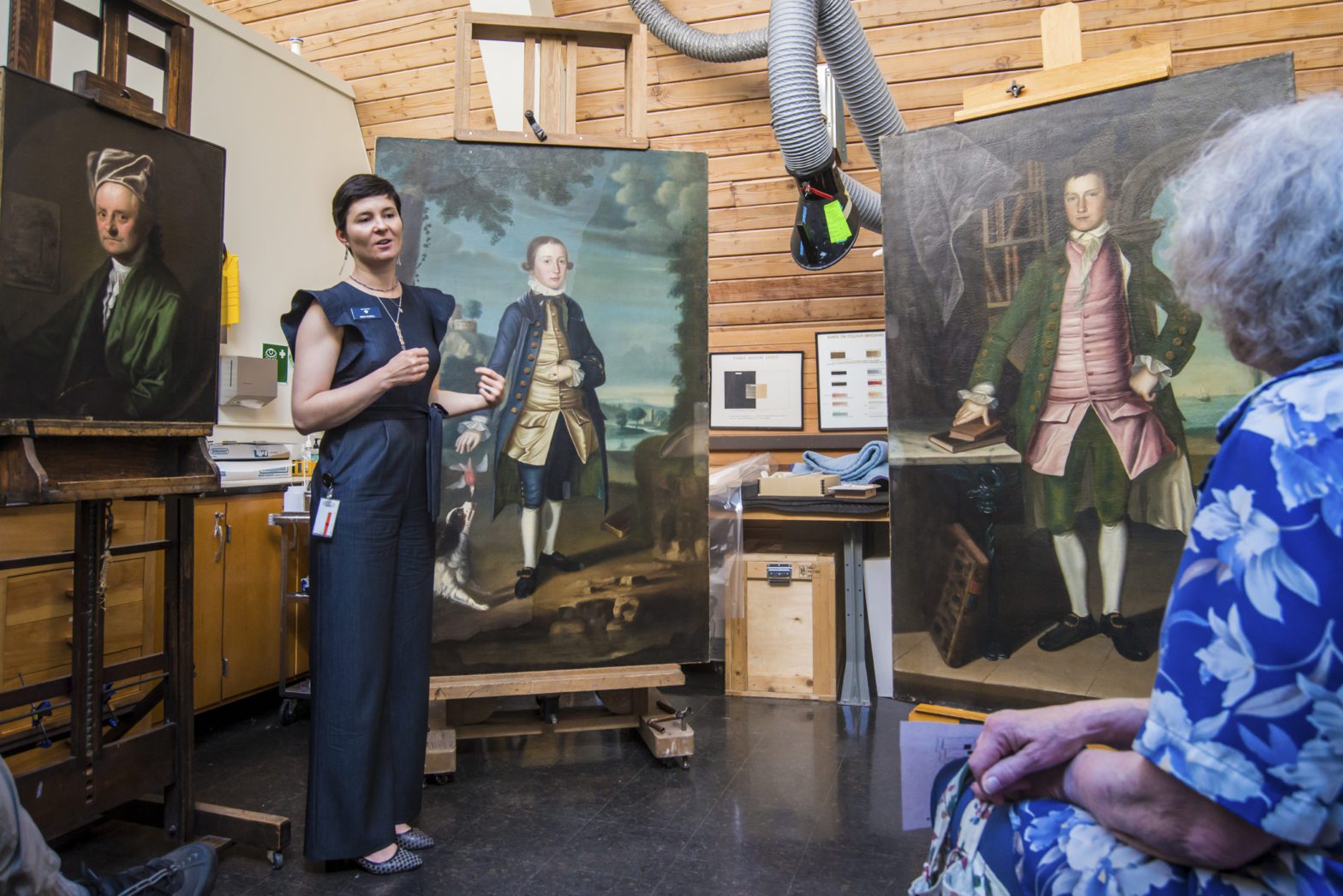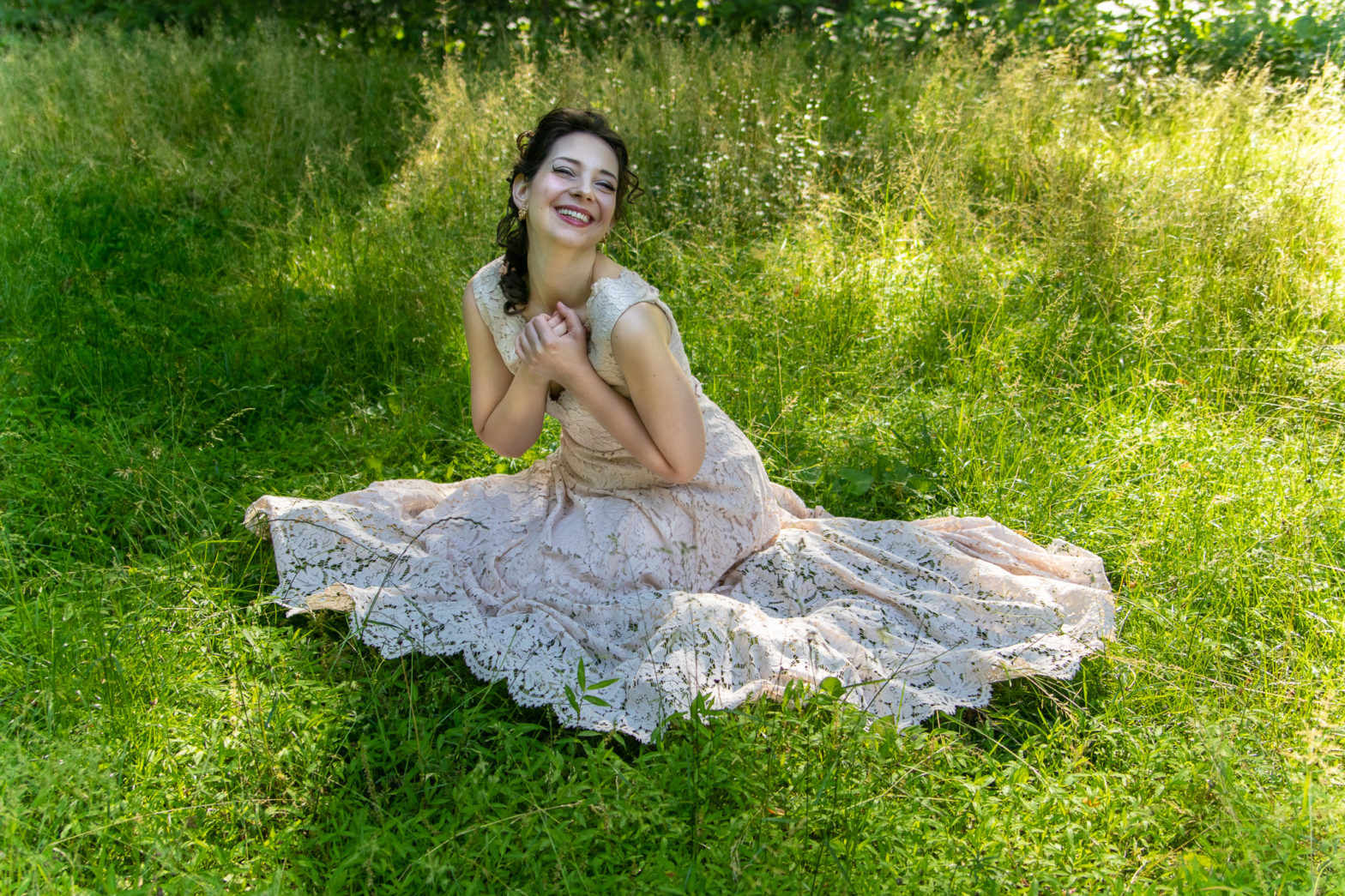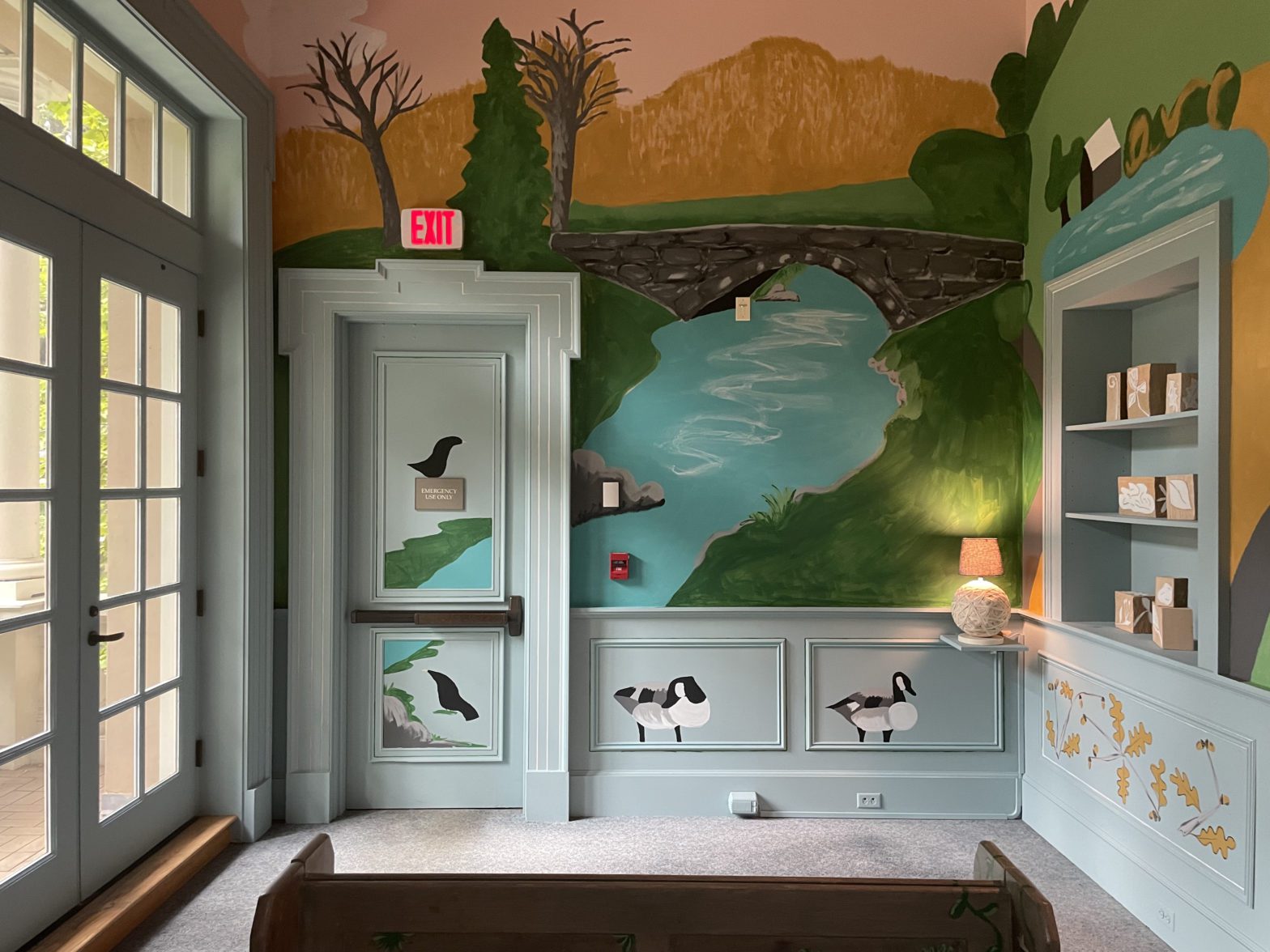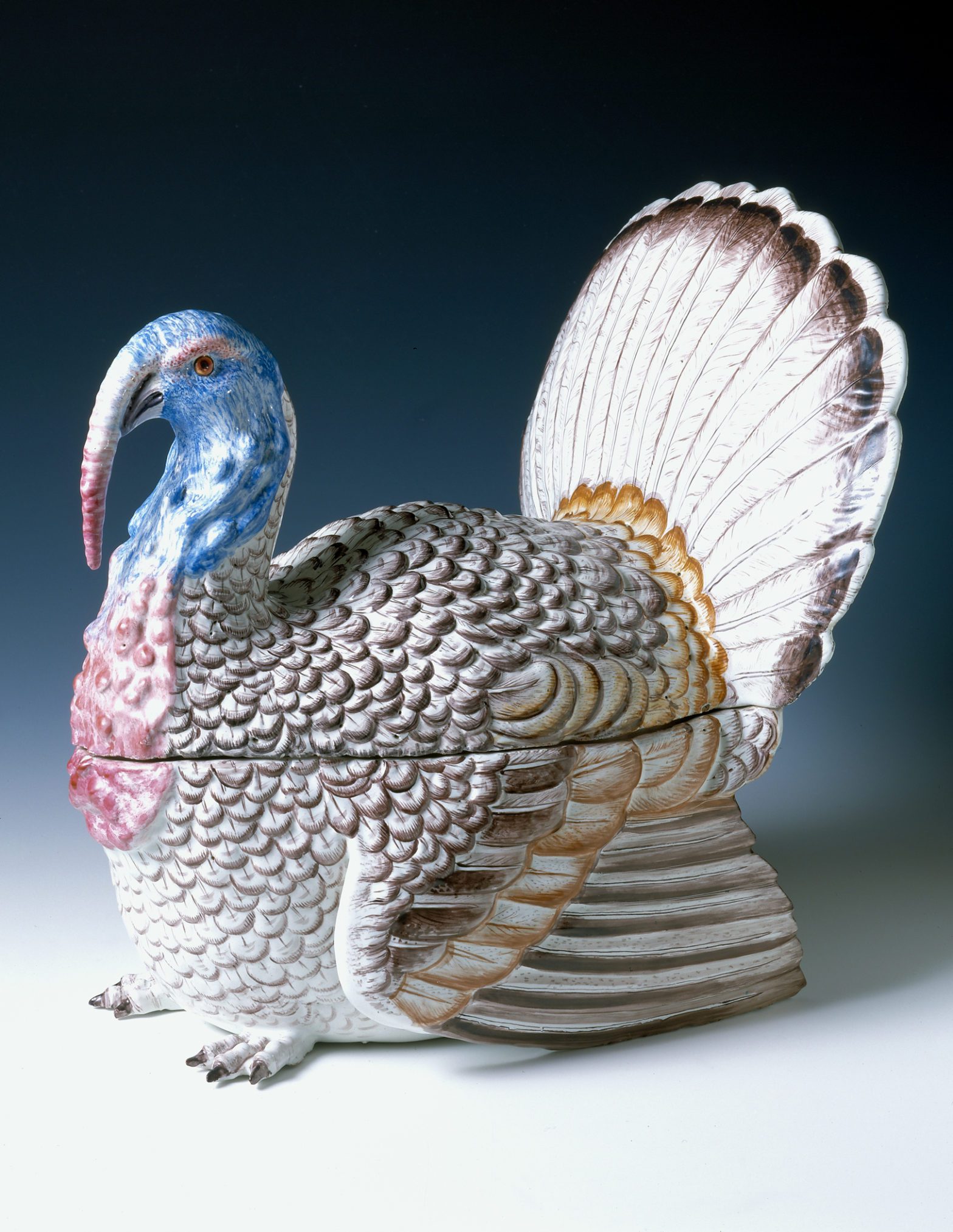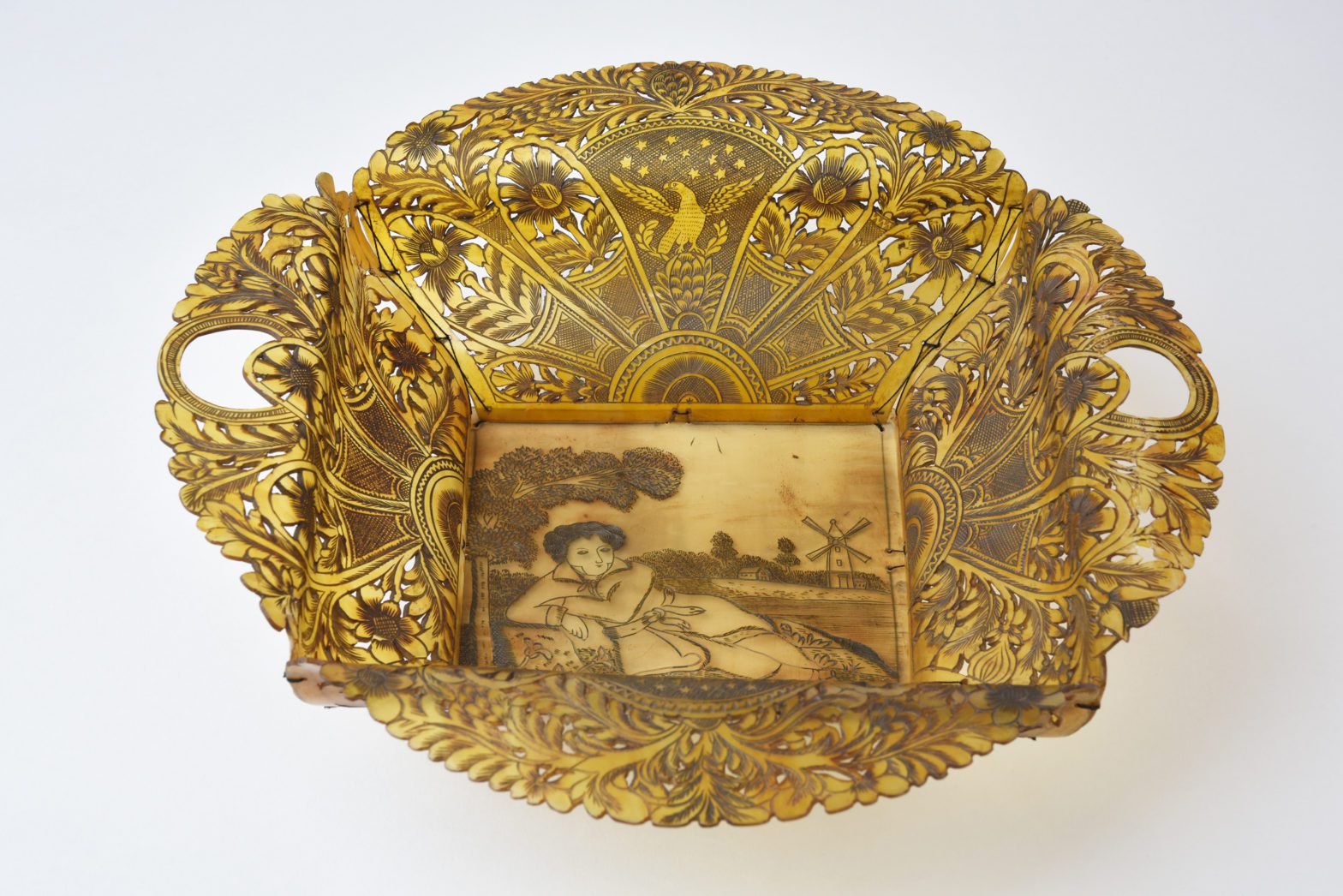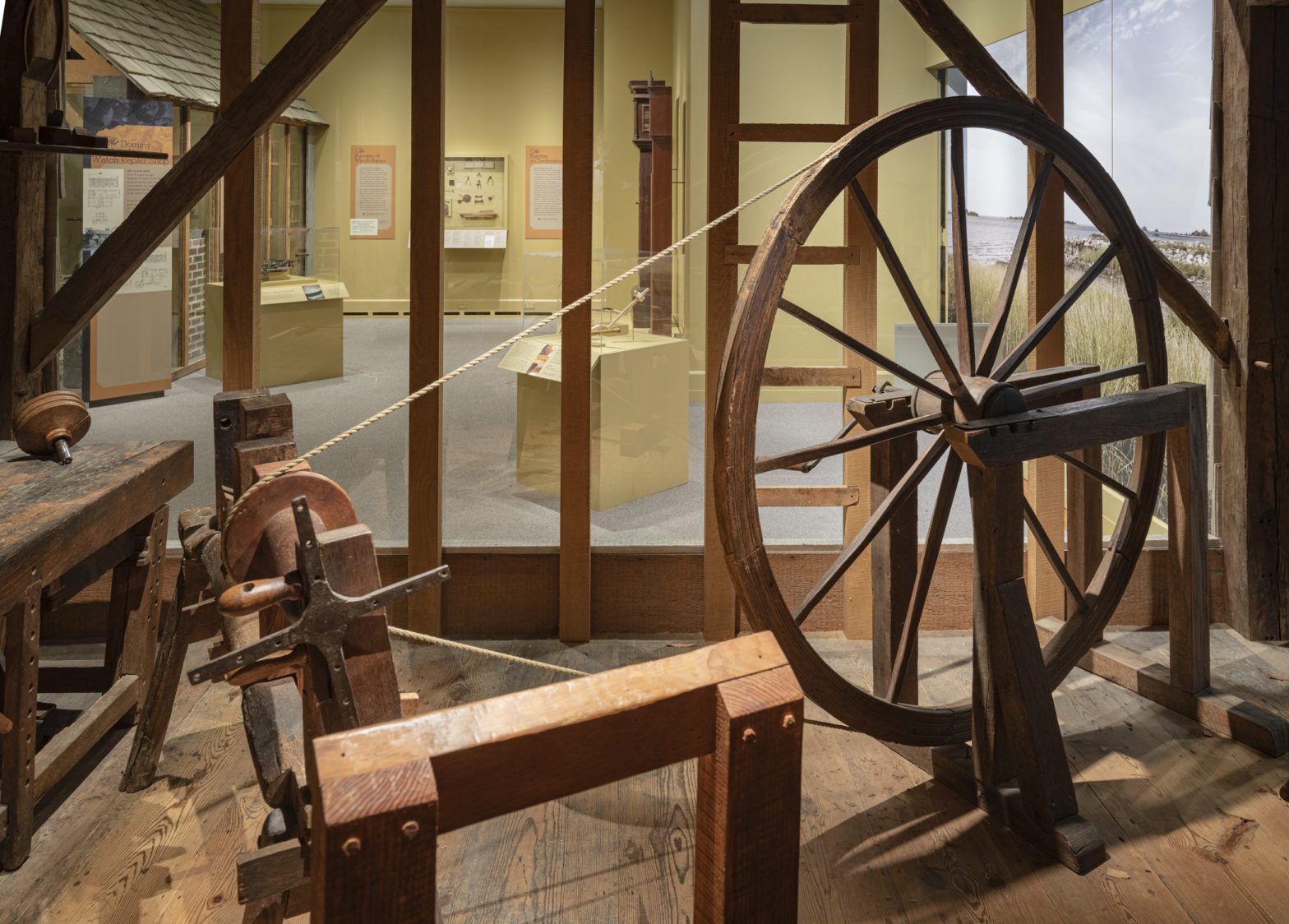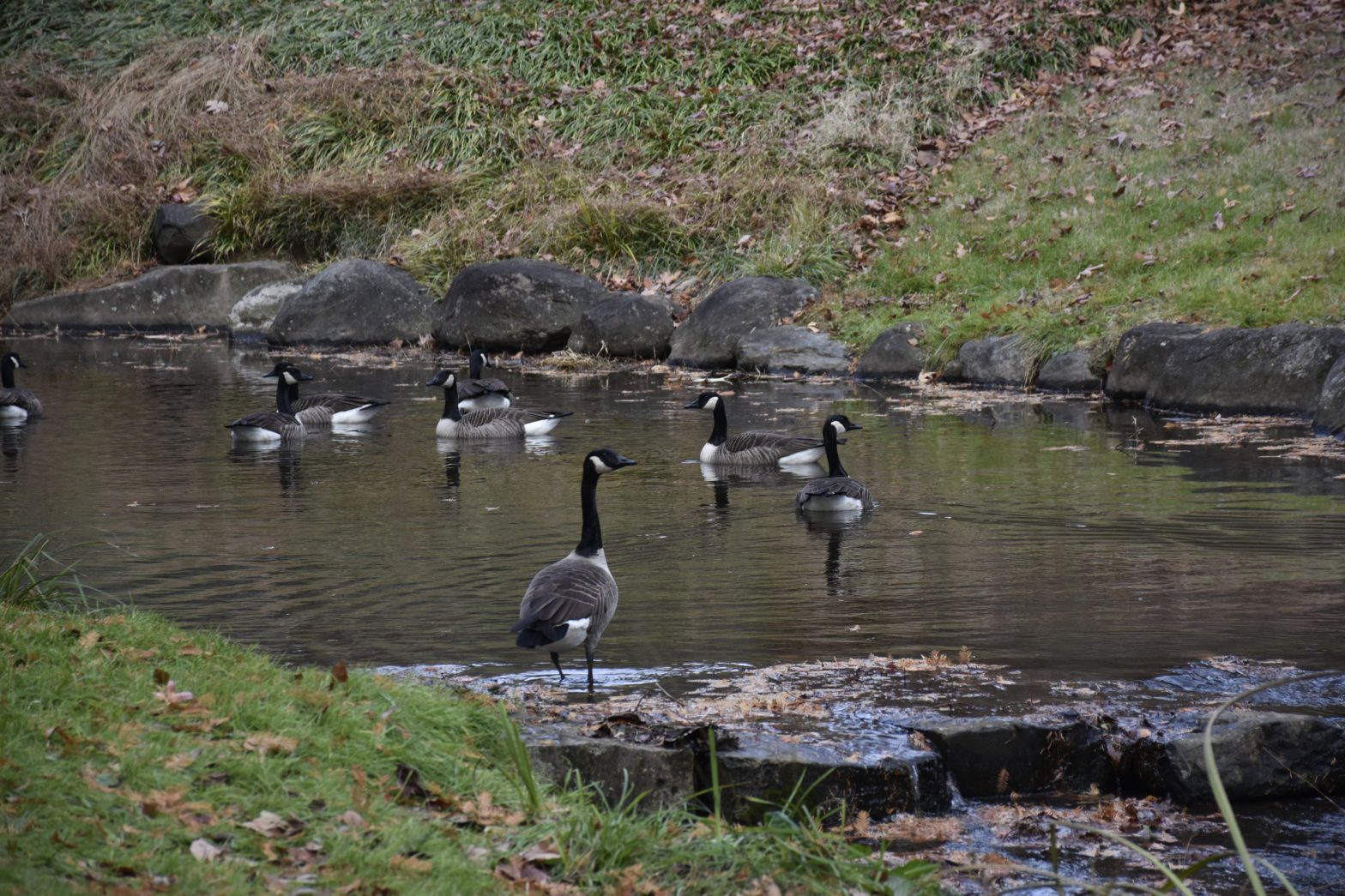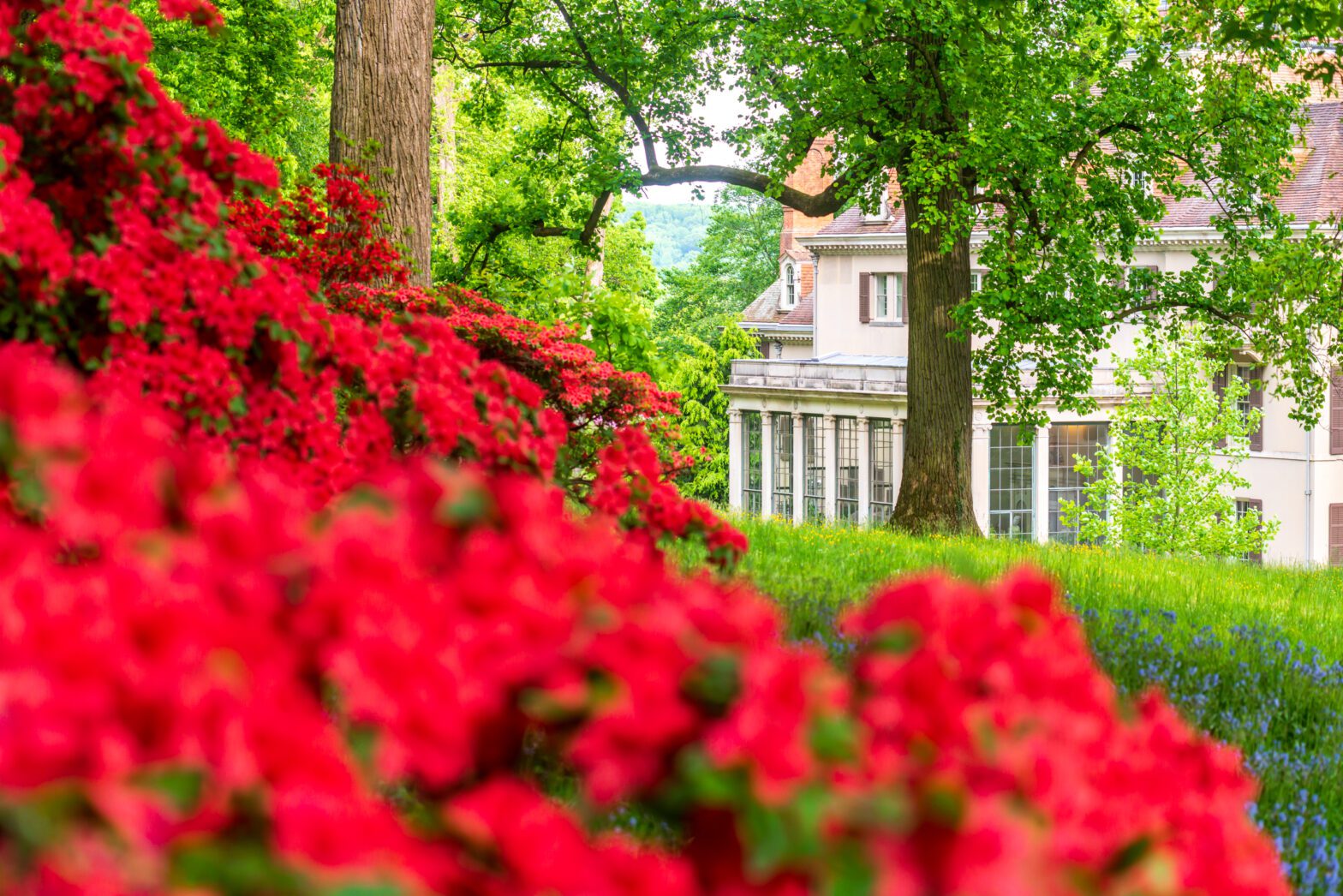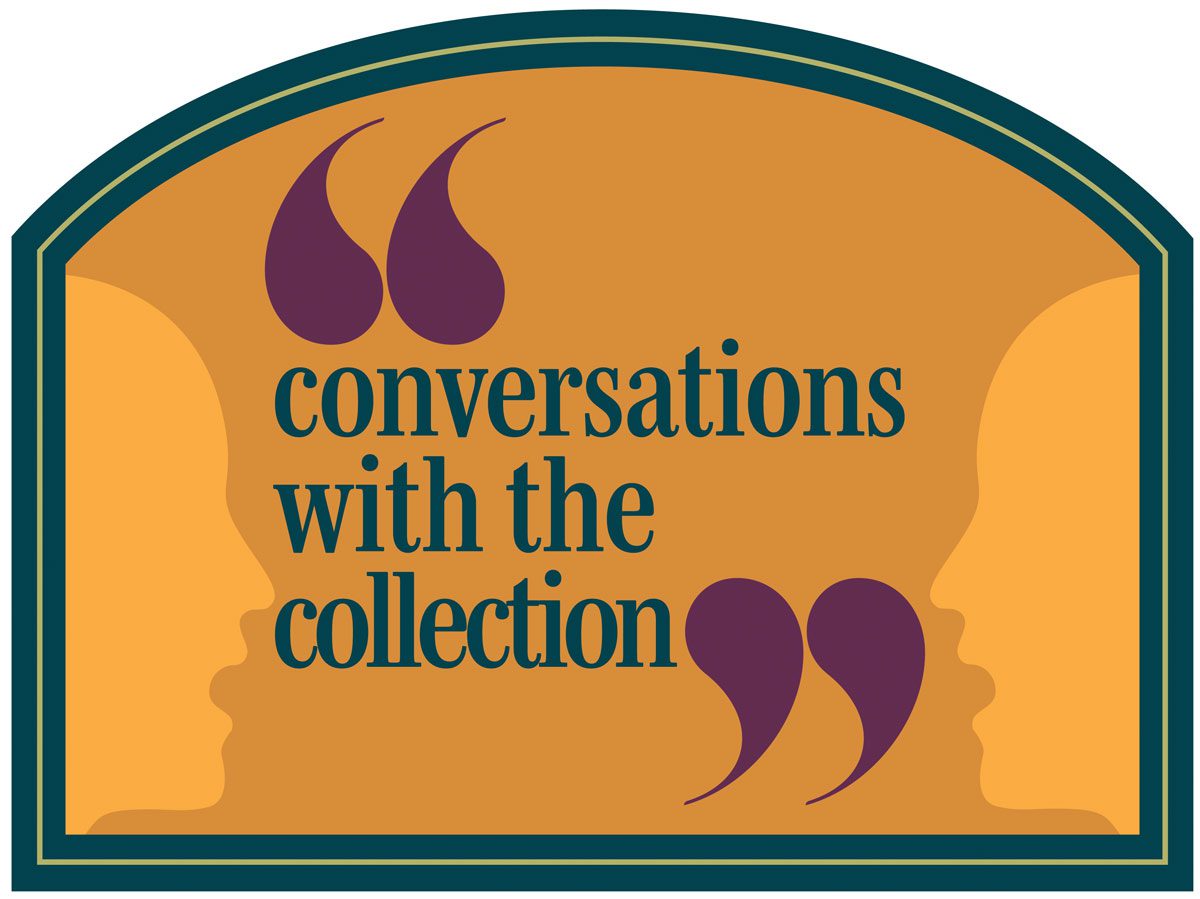Elissa Edwards and Élan Ensemble
Elissa Edwards combines historic music and sounds from nature to create a unique soundtrack.
While researching the wide range of historical scores in the Winterthur Library, Elissa Edwards found many pieces that celebrated the rich tradition of nature-themed music.
“I just wanted to look at everything,” Edwards says. “I dug deeply into the music collections and really took a lot of notes, documenting what was there because I was delighted to find this wonderful collection and knew I wanted to revisit it.”
Edwards is an operatically trained exponent of early music, who has a particular interest in historical music manuscript collections owned by women as well as historical music made by women, both of which she wants to raise awareness among modern audiences. Edwards breathed new life into forgotten works from the Winterthur Library by weaving parts of them with sounds from nature to create a soundtrack for the exhibition Outside In: Nature-inspired Design. Her musical creation is part of the Transformations installation of works by contemporary artists.
Transformations highlights work by Winterthur’s Maker-Creator Fellows, who get special access to the collections and staff for research and inspiration. The installations in Transformations celebrate how Winterthur’s landscape and material culture moved the Maker-Creator Fellows to turn their impressions of the past into artistic and experiential representations that comment on the present. Outside In, with its display of bird nests, seashells, and other natural objects, explores how objects from nature inform design motifs of wallpapers, textiles, China, furniture carving, and more, and the ways those themes are integrated into interior designs.
To create the Outside In soundtrack, Edwards first selected the scores from the Winterthur collection that she wanted to record, intending to convey some sense of the breadth of the Winterthur collection. Dr. Basil Considine, a renowned musicologist and former Winterthur fellow, transcribed hand-written scores into modern editions, which made for an effortless collaboration between the musicians.
“I also knew that I wanted to work with female collaborators, then create a variety of different instrumental textures to express the playfulness of the different characteristics that you hear in the music,” she says. These included mimicking birdsong with a flute or plucking the strings of a harpsichord.
“I love the idea of using the harp because there is a beautiful early pedal harp in the Winterthur collection, and while we recorded on a modern harp, I think the sound of the harp has such an alluring quality and really highlights the sumptuousness of the collection,” Edwards says.
In various outdoor locations at Winterthur, Edwards and her husband, Jeremy Sheeler, of Awarehouse Productions, recorded the nature soundscape, capturing the burbling of Clenny Run, the buzzing of insects, and breezes blowing through the trees and meadows. He also recorded Edwards singing, embellished with baroque ornamentation techniques. They were all mixed into the soundtrack by Edwards’s brother, Ryan Edwards, of Coincident Sound.
“I approached the project as if I were the listener, thinking about what would be emotionally gripping to someone who is experiencing all of this for the first time,” Edwards says. “I think the sensory experience of that Brandywine Valley area, being by the river, takes you out of your day-to-day self and allows you to come into a place with a more thoughtful approach to what you’re doing. It’s my hope that the music transports visitors to a place of heightened historical whimsy, this kind of pastoral romanticism, which is experienced whenever you walk the Winterthur grounds and garden. It’s an absolutely delightful place to experience, and I wanted the music to have unique surprises and to captivate the listener.”
Hear Edwards’s composition in Outside In: Nature-inspired Design at Winterthur. See the work of the other Transformations artists in the galleries area.
Kim Hall and Justin Hardison, Nottene
The Winterthur landscape inspires Nottene’s redesign of the galleries lounge.
Kimberly Hall and Justin Hardison of the artist studio Nottene were looking for a way to expand their pattern design business when they decided to explore wallpaper. They both grew up in houses with wallpaper and had built memories around the images and motifs, and they carried those memories with them into the new venture. They liked wallpaper. They knew how it was made.
“But outside of that, we didn’t the history of it and why people had it,” Hardison says. “We wanted to know more.”
Online searches for more information revealed only one book. Then Hall saw a posting for the Winterthur Maker-Creator Fellowship at the Office of Research at Maryland Institute College of Art, where she is on the faculty. “The idea of being able to use the Winterthur archive and learn about old wallpaper was really appealing,” Hall says. “We found there was so much more to discover.”
Sample books and business records in the Winterthur Library quickly became key sources for understanding the history, design, and trade of wallpaper. Pennsylvania German art and Fraktur became important inspirations, as did frequent walks in the Winterthur Garden, which was a sanctuary to the young family during the Covid-19 pandemic.
“There were just endless things to discover,” Hardison says. “We spent tons of time in the research library, in the collections, going into the galleries, walking the grounds, in the storage areas. Everything felt inspiring.”
The result of their research is reflected in a redesign of the West Galleries Lounge, part of the Transformationsinstallation of works by contemporary artists. Transformations highlights work by Winterthur’s Maker-Creator Fellows, who receive special access to the collections and staff for research and inspiration. The work in Transformationscelebrates how Winterthur’s landscape and material culture moved the Maker-Creator Fellows to turn their impressions of the past into artistic and experiential representations that comment on the present.
In the lounge, usually furnished in a modern style, Hall painted a folk art mural of the Winterthur landscape with depictions of Canada geese, blossoming tree limbs, leaves, twigs, and other objects that found their way into their sketchbooks and photo library while they wandered the grounds. Hardison decorated the shelves with woodblocks carved with similar natural imagery to acknowledge their work as printmakers.
“It almost seemed too obvious that we would do wallpaper in there,” Hardison says. “What are the other options? And because we were so inspired by the grounds and some of the other things in the collection and given the theme of the exhibition, we thought it would be a perfect opportunity to build a mural with a similar kind of aesthetic.”
The effect is as pleasing as that in any Winterthur room where wallpaper—some patterned, some mural-like—plays a key role in the design.
Among what the couple learned at Winterthur, “I was impressed that, for some, wallpaper was very much a prized possession,” Hardison says. “I was very surprised to find out how wallpaper was transported, as opposed to the removable and disposable stuff nowadays. These were prized works of art that people would have pulled back down, carefully packaged, shipped across the Atlantic, and then reinstalled. That was really interesting.”
A close look at the Chinese Parlor at Winterthur, for example, shows how highly regarded the wallpaper was by Winterthur founder Henry Francis du Pont. Made in the early 18th century, du Pont discovered the paper, unused, in a warehouse in Paris. It was so old and so beautiful, he couldn’t bear to cut it to fit the walls of his parlor, so he had the ceilings coved to accommodate its full length.
“One of the things that is so special about the Maker Creator Fellowship is that it makes the collections come alive,” Hall says. “Artists and designers can use the collection to make new things. These objects are meant to be renewed. Learning the history of wallpaper made us feel stronger and more confident in what we were doing. So much of what artists struggle with is that our work is not valued in the way other things are valued. We’re carrying on a tradition that has a history and lineage. It’s culture.”
Nottene’s work, as well as the work of the other Transformations artists, is currently on view. See their lounge design in the gallery of Outside In: Nature-inspired Design at Winterthur.
From Winterthur to the White House Exhibition Explores Jacqueline Kennedy and Henry Francis du Pont’s partnership in the Historic Restoration of “The People’s House”
In 1961, the youngest first lady in American history appointed a reserved octogenarian collector from Delaware to lead her project to restore the White House interiors. The exhibition Jacqueline Kennedy and Henry Francis du Pont: From Winterthur to the White House will tell the story of this historic partnership for the first time at Winterthur, the inspiration for Mrs. Kennedy’s project. The exhibition will run May 7, 2022–January 8, 2023.
When Mrs. Kennedy moved into the most famous house in America, she described its drab interior as a combination of “dentist office and bomb shelter.” Her vision was to bring beauty and history to the White House, aided by her sense of chic. Mr. du Pont’s expertise in decorative arts and design lent credibility to the project. Together, they transformed the White House from a mere public residence into a home of grandeur and historic significance suitable for a president. By establishing a permanent collection of furniture and art, they also created a museum for all Americans.
Their restoration awakened an interest in historic preservation and interior design that is still felt today, culminating in a televised tour of the White House that became the most watched program in American history. “The television tour fascinated generations of Americans and sealed Jacqueline Kennedy in our national imagination as the first lady who brought history and beauty to the White House,” according to guest curator Elaine Rice Bachmann.
Through artifacts, archives, and images, the exhibition invites visitors to experience the behind-the-scenes collaboration between the two during this captivating period in American history. Visitors will learn about the relationship between Mrs. Kennedy and Mr. du Pont, her visit to Winterthur in May 1961, Winterthur’s role in inspiring the design of the White House’s most iconic rooms, the historical significance of the restoration, and the important role Winterthur has played at the White House ever since.
“H. F. du Pont’s role in the Kennedy restoration of the White House positions Winterthur and its influence on American preservation and interiors at the center of this story,” said Alexandra Deutsch, John L. and Marjorie P. McGraw Director of Collections at Winterthur. “Mrs. Kennedy’s iconic visit to Winterthur in 1961 launched her on a path of creating the White House we know today. The interiors of the museum helped shape that lasting vision, which she enacted in just three short years.”
ABOUT WINTERTHUR MUSEUM, GARDEN & LIBRARY
Winterthur—known worldwide for its preeminent collection of American decorative arts, naturalistic garden, and research library for the study of American art and material culture—offers a variety of tours, exhibitions, programs, and activities throughout the year. Admission includes the Winterthur Garden, galleries, and a museum tour (by reservation).
Winterthur, located on Route 52, six miles northwest of Wilmington, Delaware, and five miles south of U.S. Route 1, is open Tuesday–Sunday, 10:00 am–5:00 pm, except during the holiday season, November 20, 2021–January 2, 2022. During the holiday season, Winterthur is open daily, 10:00 am–5:00 pm (house tours by reservation, 10:00 am–4:00 pm with last tour at 3:15 pm) and closed on Thanksgiving and Christmas. General admission is $20 for adults; $18 for students and seniors; $6 for ages 2–11. Holiday admission is $25 for adults; $23 for students and seniors; $6 for ages 2–11. Memberships are available for free and discounted admission. Winterthur is committed to accessible programming for all. For information, including special services, call 800.448.3883, or visit winterthur.org. Winterthur is closed seasonally from early January through late February.
For the latest information on safety guidelines, visit winterthur.org/faq.
Object of the Month: Ceramic Turkey Tureen
In the 1500s, Spaniards introduced domesticated turkeys from the Americas to the world. In other countries, the bird was valued for its exotic appearance as well as its tasty meat. Here, turkeys would come to represent the American Thanksgiving.
This ceramic tureen in the form of a turkey was created in France in the mid-1700s at the Strasbourg factory. (Others were made in Germany and elsewhere.) Though it is tempting to assume it was intended specifically for serving a stew or soup made from turkey, it probably was used to contain a range of tempting hot foods.
Tureens in naturalistic animal and vegetable shapes were popular elements of fashionable table settings. Such a tureen would have been at home on a table with dishes shaped like cabbages or cauliflowers and dinner plates painted with designs inspired by nature. In some cases, moss, potted plants, or flowers helped to complete the theatrical quality of the dinner display.
Winterthur curator Leslie Grigsby has long embraced the idea of bringing nature to her dinner table. For special meals, she often creates a centerpiece by arranging her favorite ceramic animal figures among greenery and fall leaves gathered from outside her home.
Leslie B. Grigsby, senior curator of ceramics and glass
Ceramic turkey tureen, Strasbourg factory, France, 1750-1760
Object of the Month: Hornware Basket
“Autumn and apple-picking are always paired thoughts in my mind, and the squared form of this basket when made by tinsmiths was used for apples, but this one is made from translucent cattle horn. The S-curved sides are engraved and pierced with the American national eagle and stars surrounded by leaves and blooming flowers very much in the manner of lady’s high back combs of the 1830s. I knew the hair comb industry was prolific, but horn baskets are unusual survivors. When I found this one in an antique shop, it was a natural fit for the collection. With a little help from Winterthur’s conservators to make new laces and stabilize the sides, it is now ready for display.”
Ann Wagner, senior curator
Basket, probably made in Rhode Island or Massachusetts, ca. 1830-50
Museum purchase with funds drawn from the Centenary Fund, 2016.0020
Updated With Hammer in Hand Tells a Richer Story of the Dominy Family of Craftsmen
A signature installation at Winterthur further explores historic craft, trade, and lifeways
A reinstallation of With Hammer in Hand: A Story of American Craft at Winterthur Museum, Garden & Library refreshes and updates the story of the Dominy family, skilled craftsmen who worked and traded in East Hampton, Long Island, in the 18th and early 19th centuries.
The updated exhibition presents a more detailed, nuanced view of the Dominys as vital members of a vibrant, diverse community, which included English colonists, members of the Shinnecock and Montaukett communities, enslaved people, and free people of color, who earned their living from offshore fishing and farming.
“The Dominys reflected and helped shape the special regional identity of their community through furniture, clocks, and other objects that may appear to our eyes as common, simple, and practical, but they are beautifully designed and executed,” said Josh Lane, the Lois F. and Henry S. McNeil Curator of Furniture at Winterthur. “We want visitors to understand the Dominy craftsmen as members of a multigenerational family living under one roof with their wives and children and apprentices, and as a vital part of their community where everyone turned to them for all sorts of woodworking and small metalsmithing needs.”
Three generations of the family—Nathaniel Dominy IV (1737–1812), Nathaniel Dominy V (1770–1852), and Felix Dominy (1800–1868)—worked in the shops from the mid-18th century through about 1840. In the patchwork of communities that made up eastern Long Island, they built houses, barns, and windmills; supplied furniture, clocks, and coffins; repaired hay rakes, wagon wheels, and spinning wheels; mended watches; and helped maintain civic buildings such as schoolhouses.
With Hammer in Hand displays nearly all the contents of the Dominys’ woodworking, clock making, and watch repair shops—including lathes, workbenches, and more than 1,000 hand tools. It also contains examples of furniture and tall clocks as well as extensive shop records and family papers.
In addition, it features short video interviews with Charles F. Hummel, curator emeritus at Winterthur and the preeminent scholar of the Dominys, outlining how the collection survived and how it came to Winterthur as well as video excerpts on how the collection continues to intrigue and inspire craftspeople. A new floor-to-ceiling mural of a saltwater marsh situates the Dominys in the seaside community of their time.
Together, the tools, shop products, and written records tell a more complete story about the practices and roles of skilled craftsmen in preindustrial America than any other single grouping of artifacts and documents that have survived from this period.
With Hammer in Hand: A Story of American Craft is a permanent exhibition at Winterthur and is included as part of general admission.
ABOUT WINTERTHUR MUSEUM, GARDEN & LIBRARY
Winterthur—known worldwide for its preeminent collection of American decorative arts, naturalistic garden, and research library for the study of American art and material culture— offers a variety of tours, exhibitions, programs, and activities throughout the year. Admission includes the Winterthur Garden and galleries.
Winterthur, located on Route 52, six miles northwest of Wilmington, Delaware, and five miles south of U.S. Route 1, is closed on Mondays (except during Yuletide) and on Thanksgiving and Christmas Day. Museum hours are 10:00 am–5:00 pm, Tuesday–Sunday. $20 for adults; $18 for students and seniors; $6 for ages 2–11. Memberships are available for free and discounted admission. Winterthur is committed to accessible programming for all. For information, including special services, call 800.448.3883, 302.888.4600, or TTY 302.888.4907, or visit winterthur.org.
For the most updated information about Covid safety protocols, visit winterthur.org/faq.
Contact: Mark Nardone
Mnardone@winterthur.org
302.888.4803 O 302.500.2559 M
Bloom Report
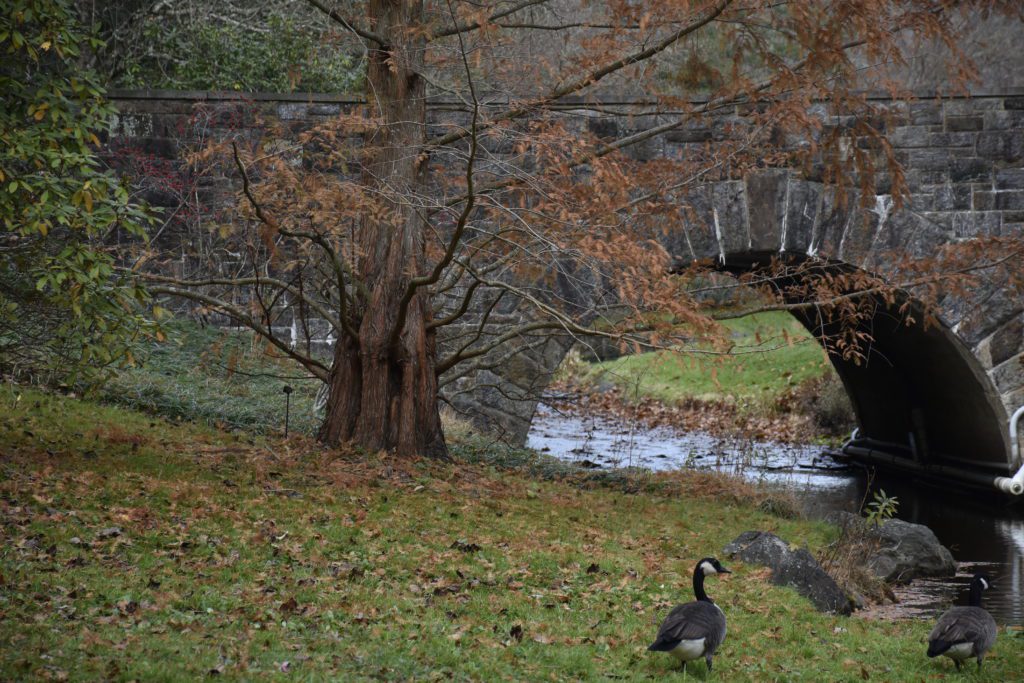
WINTERTHUR BLOOM REPORT #47
December 08, 2021
39F, Cloudy
+: Abundant
fbb: Flower-bud breaking
b: Some bloom
fb: Full Bloom
pf: Petals falling/drying
pb: Past bloom (few remain)
ber: Berries, fruits
Check these out:
- Masquerading as snowflakes: The tiny white flowers of the garland spiraea (Spiraea x arguta) in the Sundial Garden look like a flurry of snowflakes among their colored leaves.
- Another azalea show: Many of the azaleas are displaying lovely colored leaves – yellows, chartreuse, bronzes, purples, and some bright red. In particular, the ‘Firefly’ azalea (Rhododendron ‘Firefly’ Kurume hybrid azalea) along Garden Lane on the edge of Enchanted Woods is a show of brilliant reds.
- Pretend it’s spring:
- The forsythias are blooming on the field edge of Azalea Woods (Forsythia species) and on Sycamore Hill (Forsythia ‘Winterthur’).
- In Enchanted Woods, several azaleas (Rhododendron ‘Alight’) are blooming.
- Along the Winterhazel Walk, several Korean rhododendrons (Rhododendron mucronulatum) are blooming.
- In Azalea Woods, 2 pink tree rhododendrons (Rhododendron hybrid Winterthur Dexter #55) are blooming.
ENTRANCE DRIVE AND PARKING AREA
pb Abelia x grandiflora (Glossy abelia – rosy-bronze bracts)
ber Catalpa species (Catalpa – long, bean-like green to brown seed pods)
pf Hamamelis virginiana (American witch hazel – yellow ‘ribbons’)
pb Hydrangea paniculata ‘Grandiflora’ (Pee Gee hydrangea – greenish turning brown)
ber Viburnum dilatatum (Linden viburnum – dark red berries)
LAGOONS
ber Celastrus scandens (American bittersweet – yellow husks, orange berries)
ber Ilex verticillata (Winterberry holly – red berries)
ber Viburnum dilatatum (Linden viburnum – dark red berries)
SUMMER SHRUB SLOPE
pb Hydrangea paniculata ‘Grandiflora’ (Pee Gee hydrangea – brown)
PARKING AREA TO VISITOR CENTER
pb Osmanthus heterophyllus ‘Gulftide’ (Holly Osmanthus variety – white, fragrant)
pb Symphyotrichum cordifolium (Aster cordifolius/Blue wood aster – blue)
WALK FROM VISITOR CENTER TO UNDERPASS
pb Hamamelis virginiana (American witch hazel – yellow ‘ribbons’)
pf Hamamelis ‘Wisley Supreme’ (Chinese witch hazel variety – yellow ‘ribbons’)
WALK FROM UNDERPASS TO MUSHROOM
pb Osmanthus heterophyllus ‘Gulftide’ (Holly Osmanthus variety – white, fragrant)
AZALEA WOODS
b Forsythia species (Forsythia – yellow – reblooming – at field edge of Woods)
pb Hydrangea arborescens (Smooth hydrangea – brown)
ber Ilex opaca (American holly – red berries)
b Rhododendron hybrid Winterthur Dexter #55 (Tree rhododendron – pink – reblooming)
UPPER/EAST TERRACE AND STEPS
pb Galanthus ‘Barnes’ (Snowdrop variety – white)
fb Galanthus ‘Potter’s Prelude’ (Snowdrop variety – white)
pf Hamamelis virginiana (American witch hazel – yellow ‘ribbons’)
ber Ilex opaca ‘Goldie’ (American holly variety – yellow berries – at Upper Terrace wall)
fbb Jasminum nudiflorum (Winter jasmine – yellow – 3 flowers)
fbb Pieris japonica ‘Dorothy Wycoff’ (Andromeda cultivar – rosy pink buds)
EAST FRONT OF MUSEUM & Around Corner
pb Abelia x grandiflora (Glossy abelia – soft pink, rosy-bronze bracts)
ber Callicarpa species (Beautyberry – purple berries)
ber Ilex opaca (American holly – red berries – behind Bath House)
WALK FROM GLASS CORRIDOR TO REFLECTING POOL
pb Abelia x grandiflora (Glossy abelia – rosy-bronze bracts)
b Clematis ‘Candida’ (Large flowered clematis – white – reblooming)
pb Hydrangea paniculata ‘Tardiva’ (Panicle hydrangea cultivar – brown)
b Viburnum macrocephalum ‘Sterile’ (Snowball viburnum – greenish white – reblooming)
WALK FROM FISH PONDS – THE GLADE – TO BRIDGE
ber Callicarpa species (Beautyberry – white)
pb Hydrangea arborescens (Smooth hydrangea – brown)
MARCH BANK
ber Ilex opaca (American holly – red berries)
MAGNOLIA BEND AND WALK ON SOUTH SIDE OF STREAM
pb Hydrangea arborescens (Smooth hydrangea – brown)
pb Hydrangea quercifolia (Oak leaf hydrangea – brown)
GARDEN LANE
ber Crataegus viridis (Green hawthorn – red berries)
ber Koelreuteria paniculata (Golden rain tree – brown seed pods)
b Prunus subhirtella ‘Autumnalis’ (Autumn rosebud cherry – pale pink to white)
b Viburnum farreri (Fragrant viburnum – pale pink to white – reblooming)
WINTERHAZEL WALK
b Corylopsis species (Winter hazel – pale yellow – few blooms – reblooming)
b Rhododendron mucronulatum (Korean rhododendron – rosy lavender – reblooming)
PINETUM
b Chaenomeles species & varieties (Flowering quince – red, bright orange, pale orange – reblooming)
ber Pyracanthus ‘Mohave’ (Firethorn – orange berries)
fb Viburnum macrocephalum ‘Sterile’ (Snowball viburnum – greenish white – reblooming)
SUNDIAL GARDEN
fb Spiraea x arguta (Garland spiraea – white – reblooming)
fb Viburnum macrocephalum ‘Sterile’ (Snowball viburnum – greenish white – reblooming)
TRAFFIC CIRCLE
ber Callicarpa species (Beautyberry – purple, white berries)
ber Viburnum dilatatum ‘Xanthocarpum’ (Linden viburnum variety – yellow berries)
ENCHANTED WOODS
ber Callicarpa species (Beautyberry – purple berries – few left)
ber Chionanthus retusis – Chinese fringe tree – purple-black berries)
fb Hamamelis virginiana (American witch hazel – yellow ‘ribbons’)
pb Hydrangea arborescens ‘Annabelle’ (Smooth hydrangea – brown)
pb Hydrangea arborescens ‘Grandiflora’ ‘Hills of Snow’ (Smooth hydrangea – brown)
pb Hydrangea quercifolia (Oakleaf hydrangea – greenish to brown)
pb Hydrangea serrata ‘Shirofuji’ (Mountain hydrangea – brown)
fb Rhododendron ‘Alight’ (Glenn Dale hybrid azalea – white with purple – reblooming)
ber Viburnum setigerum (Tea viburnum – bright red-orange berries – few left)
OAK HILL–East Side
ber Callicarpa species (Beautyberry – purple berries)
ber Viburnum dilatatum ‘Xanthocarpum’ (Linden viburnum variety – yellow berries)
ber Viburnum setigerum (Tea viburnum – bright red berries)
OAK HILL-West Side
ber Cornus florida (Dogwood – bright red berries)
ber Viburnum dilatatum (Linden viburnum – red berries)
ber Viburnum setigerum (Tea viburnum – red-orange berries)
QUARRY, ADJACENT WALKS, AND OUTLET STREAM
ber Clematis heracleifolia var. davidiana (Tube clematis – ‘fluffy’ tan seed heads)
ber Cornus officinalis (Japanese cornel dogwood – bright red berries)
ber Euonymus alata (Winged euonymus – red berries)
fbb Pieris ‘Forest Flame’ (Andromeda variety – dark rosy-pink buds)
SYCAMORE HILL
ber Catalpa species (Catalpa – long, bean-like brown seed pods)
ber Cotoneaster salicifolia (Cotoneaster – bright red berries)
fb Forsythia ‘Winterthur’ (Winterthur forsythia – golden yellow – reblooming)
pb Hydrangea paniculata ‘Grandiflora’ (Pee Gee hydrangea – brown)
fbb Rosa ‘New Dawn’ (New Dawn rose – palest pink – 4 buds)
ber Rosa ‘Radwin’ (Winner’s Circle rose – orange rose hips)
fb Viburnum macrocephalum ‘Sterile’ (Snowball viburnum – greenish white)
b Viburnum plicatum forma tomentosum ‘Shasta’ (Doublefile viburnum – white – reblooming)
fb Viburnum rhytidophylloides (Leatherleaf viburnum – off-white)
ber Viburnum setigerum (Tea viburnum – red berries)
WEST FRONT OF MUSEUM, COTTAGE, AND CLENNY RUN
pf Camellia ‘Northern Exposure’ (Camellia variety – white)
pb Camellia oleifera ‘Lu Shan Snow’ (Camellia variety – white)
pf Camellia sasanqua/oleifera (Camellia variety – white)
fb Camellia ‘Snow Flurry’ (Camellia variety – double white)
pf Camellia ‘Survivor’ (Survivor camellia – white)
pf Camellia ‘Winter’s Snowman’ (Camellia variety – double white)
pb Camellia x ‘Mason Farm’ (Mason Farm camellia – white)
fb Hamamelis virginiana (American witch hazel – yellow ‘ribbons’ – at parking lot wall)
pf Hamamelis x intermedia (Hybrid witch hazel – yellow ‘ribbons’ – on lower side of The Cottage)
pb Hydrangea arborescens (Smooth hydrangea – brown)
pb Hydrangea quercifolia (Oakleaf hydrangea – brown)
ber Ilex verticillata (Winterberry holly – red berries)
ber Viburnum dilatatum (Linden viburnum – red berries – along Clenny Run)
pb Viburnum rhytidophylloides (Leatherleaf viburnum – off-white – along Carriage House)
GREENHOUSE AREA
ber Ilex opaca (American holly – red berries)
BACK MEADOW – Top of Sycamore Hill to back ponds
ber Celastrus scandens (American bittersweet – yellow husks, orange berries)
GARDEN LANE MEADOW – below Brown’s Woods
ber Catalpa species (Catalpa – long, bean-like brown seed pods)
Bloom Report presented by: Pauline Myers
Group Tours
Be Our Guest!
Explore this place of beauty, history, and learning! Winterthur offers special rates for groups of 15 or more people. We are happy to work with you to customize your visit. To book your tour, please call 800.448.3883 or email grouptours@winterthur.org
Admission includes: a self-guided tour of elegantly furnished rooms in which Henry Francis du Pont entertained his family and friends in grand style; a narrated tram tour* through the 60-acre garden and its succession of show-stopping blooms; the Campbell Collection of Soup Tureens; exhibitions; and access to Winterthur’s world-class research library. Please plan to spend about three hours.
Winterthur has on-site dining in the Visitor Center Cafeteria. Boxed lunches are available by pre-order (see below) or your group may go through the line.
Group Rates
A minimum of 15 visitors are required per group to receive the General Admission group rate of $22 ($26 during Yuletide at Winterthur). Receive two complimentary tickets for 15 paid admissions.
No deposit is required. Payment in full is due one week prior to tour date. Group Tours are available by advance reservation only. We recommend booking your group tour at least four to six weeks prior to your desired tour date.
To reserve your group tour, please fill out this form or contact us at grouptours@winterthur.org or by calling 800.448.3883.
*March through December, weather permitting. Trams are shared with the general public and are available on a first-come, first-served basis.
Guided Garden Walks
Discover horticultural secrets on guided garden walks. $50 per group, optional add-on.
Boxed Lunches
Select Two
$17.50 per box
- Roasted turkey with applewood smoked bacon, tomato, and lettuce with garlic aioli on a brioche
- Grilled chicken with romaine lettuce, pecorino cheese, and Caesar dressing in a tortilla wrap
- Roast beef with caramelized onions and arugula with blue cheese aioli on a ciabatta
- Honey-baked ham with tomato, lettuce, Swiss cheese, and honey Dijon mustard on a brioche
- Balsamic-roasted squash with tomato confit, red onion, feta cheese, sundried-tomato pesto, and spinach on a ciabatta
- Grilled portobello mushroom with roasted bell pepper, Boursin cheese, arugula, and balsamic vinaigrette in a tortilla wrap
- Smashed-chickpea and avocado with feta cheese, tomato, red onion, watercress, and green goddess dressing on seven-grain bread
- Mixed-greens salad with citrus segments, shaved fennel, and toasted pine nuts with a citrus vinaigrette
- Spinach salad with strawberries, red onion, and candied pecans with strawberry balsamic dressing
$19.00 per box
- Genoa salami with spicy soppressata, tomato confit, marinated artichokes, mozzarella, arugula, and lemon-basil pesto on a ciabatta
- Cilantro-lime shrimp with romaine lettuce, avocado, and chipotle slaw on a tortilla wrap
- Grilled marinated steak with sautéed peppers and onions, provolone cheese, and herbed mayo on a ciabatta
All boxed lunches include a bag of chips, fresh fruit, house-baked cookie, a bottle of water, and eco-friendly cutlery.
Sandwich selections and counts are due 5 business days prior to your visit. Please ask your catering representative about private seating, delivery, or customized options.


Conversations with the Collections
Ongoing in the First-floor Galleries.
Learn how Winterthur staff and students use the museum collection to understand America’s material past. See what’s new to the collection and join curators and conservators in looking closely at objects to better understand both the past and the present.
Objects currently on view include new acquisitions that curators are using to tell a more comprehensive story of American design and craft. They include examples from the nineteenth, twentieth, and twenty-first centuries. These works also help us better understand global influences on American material culture, past and present.
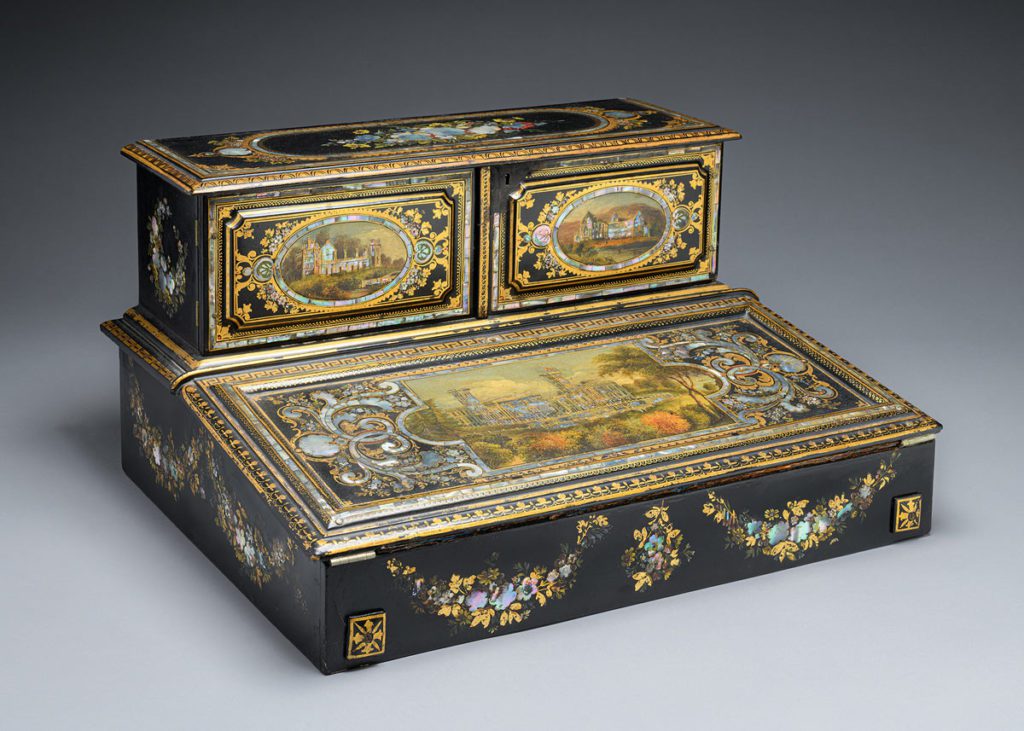
Work table
Attributed to Jennens and Bettridge
Birmingham, England; 1840–60
Papier-mâché, silk, paint, mother-of-pearl
Gift of Edward and Linda Mitchell 2020.0018a-c
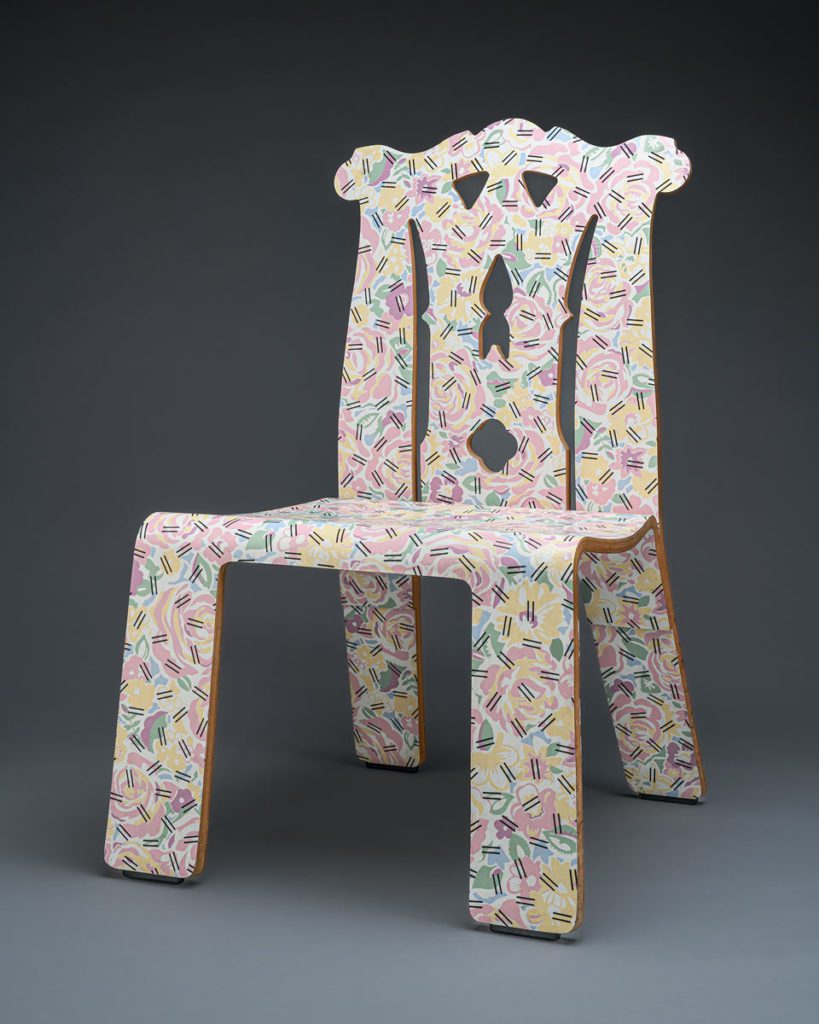
Chair
Robert Venturi and Denise Scott Brown for Knoll International
New York, New York; 1984
Plywood
Museum purchase with funds provided by the Henry Francis du Pont Collectors Circle 2019.0004
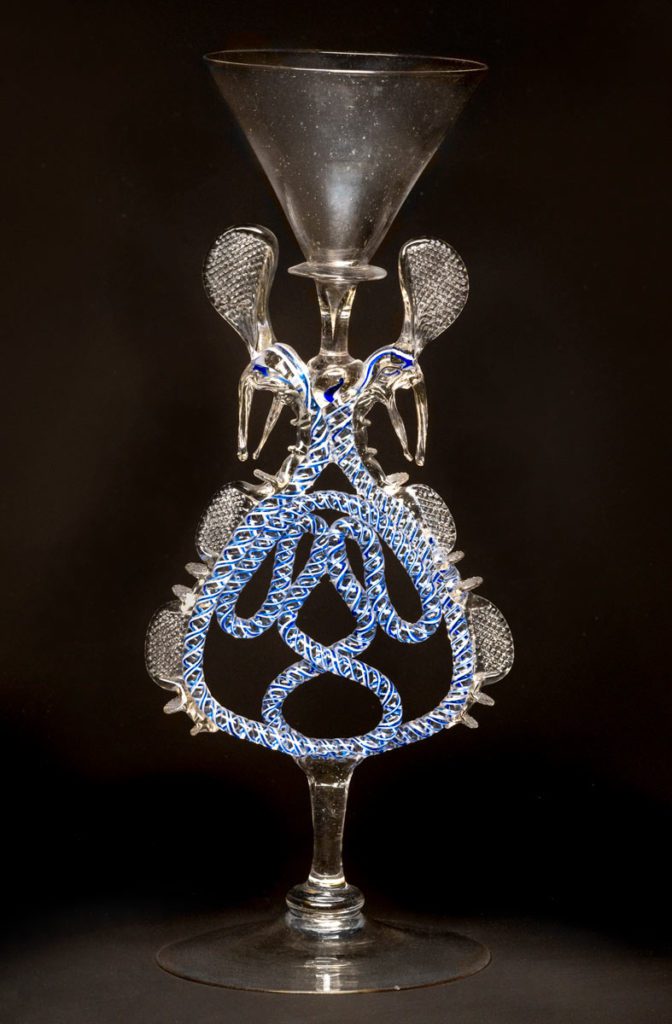
Wineglass
Netherlands or Germany; 1660–1700
Glass (nonlead)
Museum purchase with funds provided by Dwight and Lorri Lanmon and the Henry Francis du Pont Collectors Circle 2019.0045
